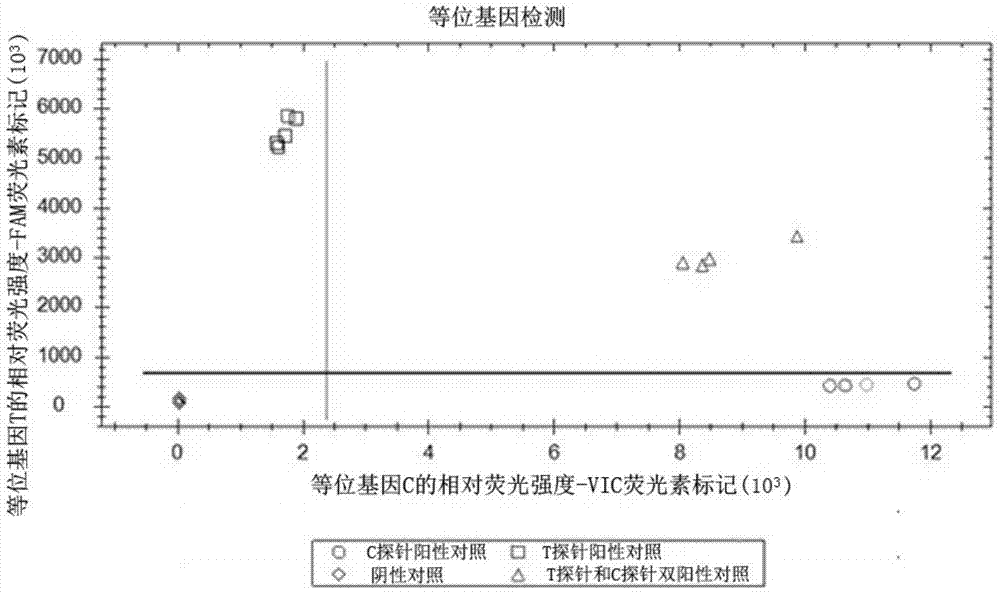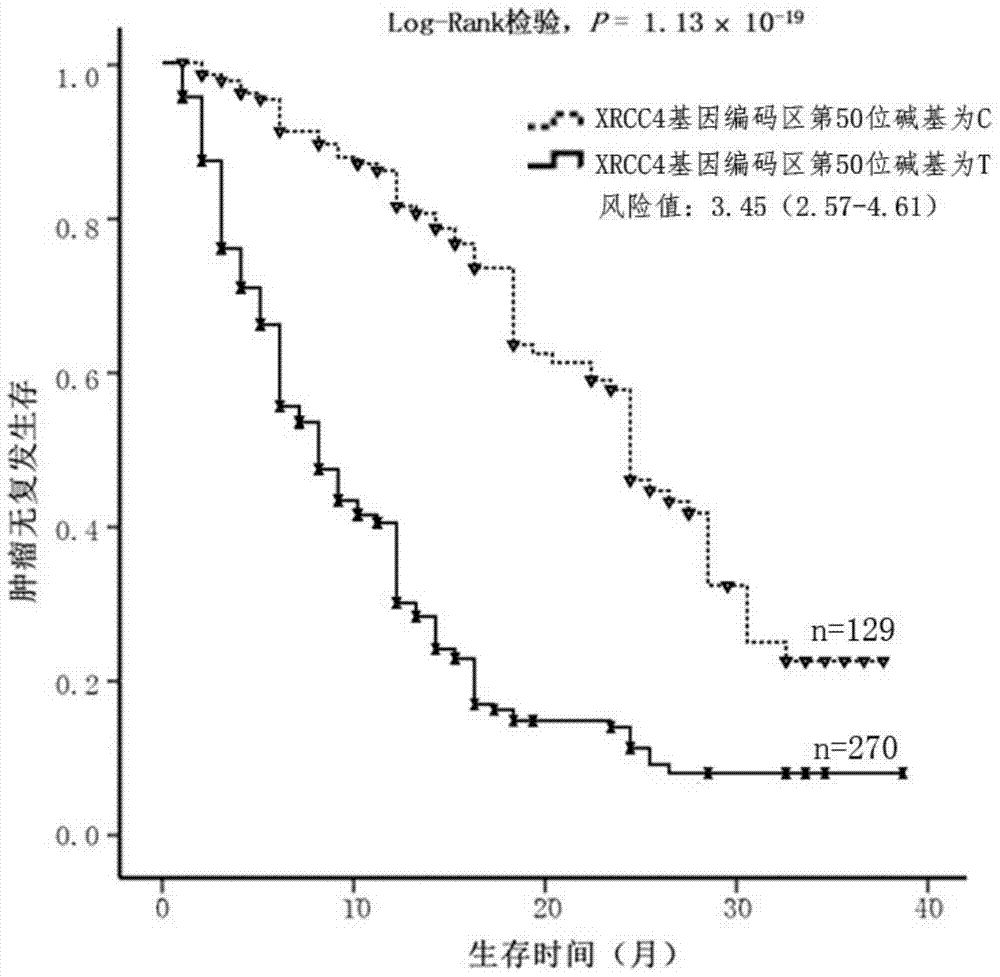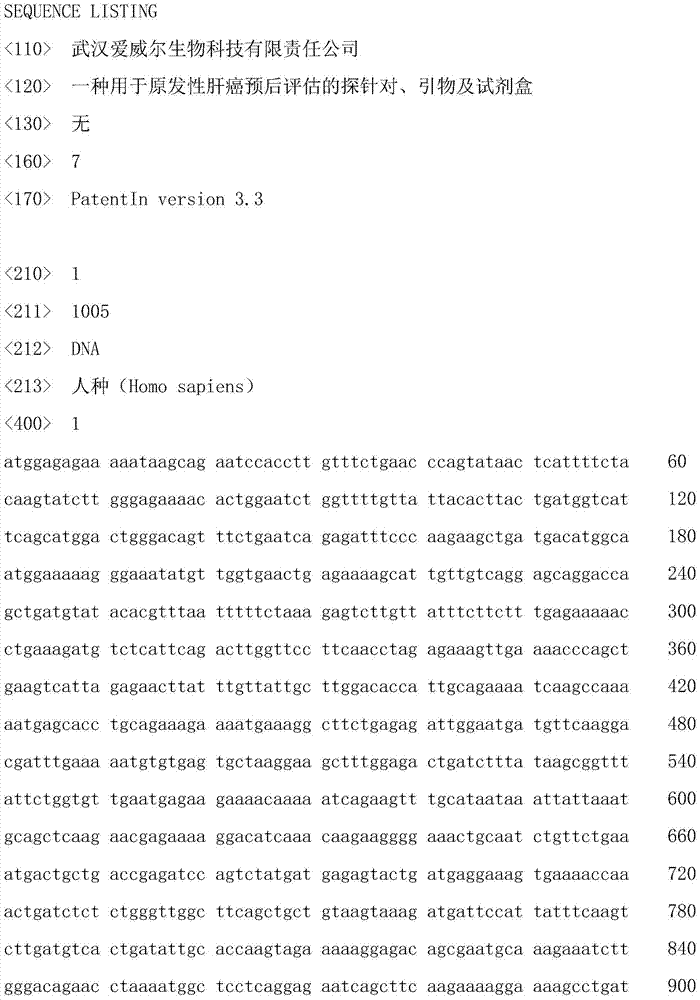A probe pair, primer and kit for prognostic assessment of primary liver cancer
A kit and probe technology, applied in the field of genetic diagnosis, can solve problems such as increasing the risk of liver cancer, achieve the effects of reducing the probability of false positive detection, accurate experimental results, and increasing the probability of specific matching
- Summary
- Abstract
- Description
- Claims
- Application Information
AI Technical Summary
Problems solved by technology
Method used
Image
Examples
Embodiment 1
[0027] The design of embodiment 1 probe and primer
[0028] After the human XRCC4 gene was sequenced, the probe sequence was designed according to its nucleotide sequence and specific detection site (the 50th base C → T in the gene coding region): 5'-AACCCAGTATAATTC-3', and the 5' The fluorophore FAM is labeled at the end, and the quencher group MGB is labeled at the 3' end as a T probe for detecting mutant XRCC4 gene fragments; at the same time, 5'-AACCCAGTATAACTCA-3' is designed, and the 5' end is labeled with a fluorophore The group VIC and the 3' end labeled quencher group MGB are used as C probes to detect wild-type XRCC4 gene fragments.
[0029] And design the PCR amplification primers as:
[0030] Upstream primer: 5'-TGGAGAGAAAAATAAGCAGAATCCA-3'
[0031] Downstream primer: 5'-TTCCAGTGTTTTTCCCCAAGATACT-3'
[0032] Use artificially synthesized variant XRCC4 gene fragment (nucleotide sequence is SEQ ID NO: 6), wild-type XRCC4 gene fragment (nucleotide sequence is SEQ ID...
Embodiment 2
[0033] Embodiment 2 is used for detecting the kit of human XRCC4 gene mutation
[0034] A kit for detecting the C→T mutation of base 50 in the coding region of the human XRCC4 gene, the main components of which are shown in Table 1:
[0035] Table 1
[0036] serial number
Composition
Specification
quantity
1
1200μl
1 stick
2
2×Taqman enzyme reaction solution
1200μl
1 stick
3
10×PCR amplification solution
200μl
1 stick
4
C Probe Positive Control
10μl
1 stick
5
T probe positive control
10μl
1 stick
6
T probe and C probe double positive control
10μl
1 stick
7
10μl
1 stick
8
Optical 96-well reaction plate
Piece
1 block
9
open
1 piece
10
manual
share
1 copy
[0037] The 2×Taqman enzyme reaction solution includes 2 kinds of fluorescentl...
Embodiment 3
[0047] Example 3 Correlation between liver cancer recurrence and XRCC4 gene mutation
[0048] Step 1: Collect liver cancer tumor samples and extract genomic DNA
[0049] A total of 399 tumor tissue specimens from patients with sporadic primary hepatocellular carcinoma were collected from the Affiliated Hospital of Youjiang Medical College for Nationalities, with an average age of 47.8±10.4 years (standard deviation), including 51 female specimens.
[0050] Tumor cells were isolated from the tumor tissue specimens collected above by proteinase K cleavage method, and sample DNA in tumor cells was extracted by phenol-chloroform method, and the sample DNA was uniformly diluted to 50 ng / μL as the DNA template to be tested.
[0051] Step 2: Detection of C→T mutation at base 50 in the XRCC4 gene coding region
[0052] Using the kit in Example 2, each DNA template to be tested was subjected to an amplification reaction with a total volume of 25 μL in a single well of a 96-well plate....
PUM
 Login to View More
Login to View More Abstract
Description
Claims
Application Information
 Login to View More
Login to View More - R&D
- Intellectual Property
- Life Sciences
- Materials
- Tech Scout
- Unparalleled Data Quality
- Higher Quality Content
- 60% Fewer Hallucinations
Browse by: Latest US Patents, China's latest patents, Technical Efficacy Thesaurus, Application Domain, Technology Topic, Popular Technical Reports.
© 2025 PatSnap. All rights reserved.Legal|Privacy policy|Modern Slavery Act Transparency Statement|Sitemap|About US| Contact US: help@patsnap.com



